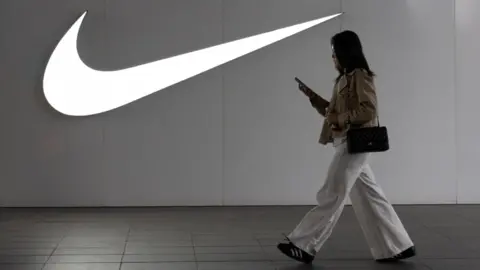Business reporter
Business reporter
 EPA-EFE/REX/Shutterstock
EPA-EFE/REX/ShutterstockNike says US President Donald Trump’s tariffs on key trading partners could add around $1bn (£730m) to its costs this year.
Company executives also said the sportwear giant would cut its reliance on producing goods in China to ease the impact of US trade policies.
Last month, Nike said it would raise prices on some trainers and clothing in the US from early June, weeks after rival Adidas warned it would have to hike the cost of goods due to tariffs.
Separately, both the US and China say they have agreed on how to implement a trade agreement they reached earlier this month.
It involves Beijing sending more rare earth metals to the US in return for the lifting of export restrictions.
Nike shares rally
Shares in Nike jumped by more than 10% in extended trading after it forecast a smaller drop in first quarter revenue than many analysts had expected.
The company’s earnings for the last three months also topped estimates, despite being its worst quarterly figures for more than three years.
Nike announced fourth-quarter revenue of $11.1bn – the lowest since the third quarter of 2022.
Chief financial officer Matthew Friend said the firm would move some production from China, which was hit with the biggest tariff increases, to other countries in response to Trump’s tariffs.
China currently manufactures 16% of Nike footwear that ends up in the US. Mr Friend said that figure would be cut to a “high single-digit percentage range” by the end of May 2026.
Trump announced sweeping “Liberation Day” tariffs on most goods from countries around the world on 2 April. Those plans included tariffs of 46% on goods from Vietnam and 32% on items from Indonesia, even bigger manufacturing hubs for Nike than China.
Later that month, he suspended most of those tariffs to allow for talks with the affected countries, with one top adviser promising “90 deals in 90 days”.
The move dropped tariffs to 10%, instead of the far higher rates that goods from many trading partners faced.
The White House is now facing growing questions about what the president is planning to do about tariffs, as the 90-day pause is due to expire on 9 July.
In remarks at the White House on Thursday, Trump maintained that talks were going well, pointing to the agreement reached with China and saying there was another “coming up with India, maybe”.
But he also warned: “We’re not going to make deals with everybody.
“Some we’re just going to send them a letter, say, ‘Thank you very much. You’re going to pay 25, 35, 45%.’ That’s the easy way to do it,” he said.
“My people don’t want to do it that way. They want to do some of it, but they want to make more deals than I would do,” he added.
Treasury Secretary Scott Bessent has previously raised the possibility that Trump could extend the deadline, depending on how talks are going.
On Thursday, White House spokesperson Karoline Leavitt said that the deadline was “not critical” and that Trump was prepared to present countries with “deals” that would set new tariff rates.
The US and China announced an agreement earlier this month aimed at ensuring US supply of critical magnets and rare earths, after concerns about access had risked reigniting trade tensions between the two economic superpowers.
At the White House on Thursday, Trump said he had “signed” a deal with China without giving further details. “The administration and China agreed to an additional understanding for a framework to implement the Geneva agreement,” a White House official said later.
Trade between the two sides was nearly shut down after Trump raised tariffs and China hit back in a barrage of tariffs in April that had nearly shut down trade between the two countries.
The US and China subsequently agreed to reduce – but not eliminate – those tariffs.